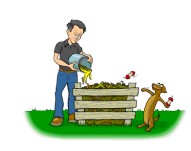About one third of the stuff we throw away is compostable! Composting is a great way to reduce how much we put in our trash.
There are four ingredients for composting:
1. Browns
2. Greens
3. Air
4. Water

Who or what makes compost?
It’s all about micro-organisms because they make compost. The micro-organisms need the right ingredients to make them happy so that they will do their job correctly.
The happier they are, the better the compost. Ok, so what makes them happy? Well, they need water, air and brown and green material. When the micro-organisms are happy they generate heat energy. The more heat, the better they are at decomposing. An active compost pile will heat to somewhere between 130 and 160 degrees Fahrenheit. That’s really hot!

So are you ready to compost? Here’s what you’ll need to get started:

1. Browns
Browns provide carbon. Here are some ideas:
-
-
Paper, like shredded pieces of used scrap paper, and old envelopes (without the plastic window)
- Dry leaves, small branches, twigs, straw, sawdust, dried grass clippings, and dried weeds without seeds
- Shredded newspaper – not the glossy section
-

2. Greens
Greens provide nitrogen and include things like:
- Fresh grass clippings, green leaves, and fresh weeds without seeds.
- Vegetable and fruit peels and scraps, coffee grounds, tea bags and coffee
filters.
Here’s why you need carbon and nitrogen:
Carbon – microbes use carbon as an energy source.
Nitrogen – microbes use this element to build proteins in their bodies.
So, carbon and nitrogen make the microbes really, really strong so they can do their job correctly.
When building your compost pile, alternate layers of greens and browns materials.
Recipe tip: mix three parts browns to one-part greens.
 3. WATER
3. WATER
Ideally your compost should have moisture content of 50% or so. That’s like the moisture level of a damp wrung out sponge. This will keep your micro-organisms happy. They don’t want it to be too wet, they don’t want it to be too dry … this is just right.
Tip: Test it out – squeeze a handful of your compost material -- it should leave your hand moist but not drip more than a few drops.
4. AIR
Your micro-organisms need air to survive.
So to keep them healthy, grab a shovel and turn over your pile every 2 to 3 weeks.
How do I know when my compost is done?
When the material is dark and rich in color and there are no remnants of your food or yard waste, then it’s ready! If it smells like dirt and crumbles in your hand then it’s ready to use.
 GOOD COMPOST MATERIALS:
GOOD COMPOST MATERIALS:
Greens:
Vegetable and fruit scraps, fresh grass clippings (if no herbicides applied), fresh weeds without seeds, coffee grounds and coffee filters, and tea leaves/tea bags. Chicken, rabbit, cow, and horse manure.
Browns:
Dry leaves, straw, dry hay, sawdust, woodchips from untreated wood, dried grass clippings, shredded paper, dried weeds without seeds, cardboard rolls, shredded newspaper.
Other materials:
Eggshells, plain rice, plain pasta, bread, used paper towels (not greasy).
 BAD COMPOST MATERIAL: Do not add:
BAD COMPOST MATERIAL: Do not add:
Meat, fish, eggs, dairy products, oily foods, bones, dog or cat manure, weeds with mature seeds, plants infected with disease, anything treated with pesticides or chemicals. Stickers from fruits or vegetables, fats, grease, lard or oils.
Written by UConn Master Composters, 2017
Questions? Contact:
UConn Soil Nutrient Analysis Laboratory
Department of Plant Science and Landscape Architecture
Phone: 860.486.4274
Email: soiltest@uconn.edu
Website: soiltesting.cahnr.uconn.edu
UConn is an equal opportunity program provider and employer.
©UConn Extension. All rights reserved.